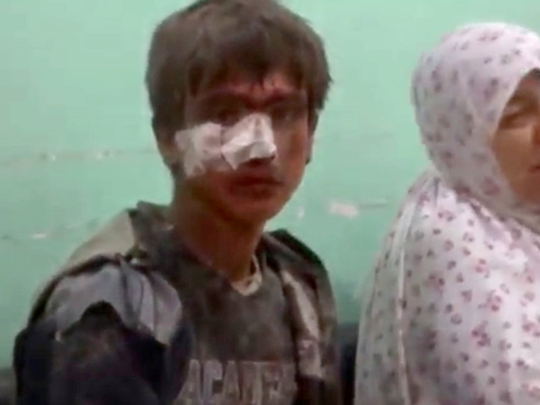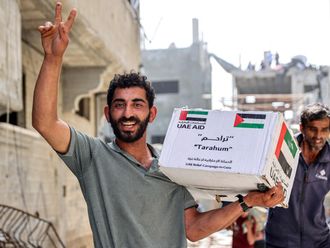
Beirut: They came from every corner of Syria: people who fled fighting but could not afford smugglers’ fees to go farther.
Now nearly one million are packed into one province in Syria’s northwest, eyeing a weeks-old ceasefire there with trepidation, fear and mistrust.
This vast and often hilly expanse along Turkey’s southern border has become the rebels’ final redoubt. In the coming months, it could become the sternest — and the bloodiest — challenge for Syrian President Bashar Al Assad’s forces as they battle to control areas they lost to rebel fighters after the country’s 2011 uprising.
A deal brokered by Russia, Turkey and Iran in June has stopped much of the violence in Idlib province and three other regions of Syria.
Across the province, a coalition of Al Qaida-linked rebels would be firmly in Al Assad’s crosshairs, with hundreds of thousands of civilians stuck in the middle.
From his tent in a packed displacement camp along the Turkish border in the days before the deal, Qassim Qadoor called his children close as a drone hovered overhead.
When it dropped its payload, he said, they ran for cover, passing the flames that savaged their neatly stacked possessions and destroyed the latest refuge for dozens of families just like them.
“We came here because there was nowhere left to go,” Qadoor said in a phone interview after the attack.
His family had been uprooted nine times since the start of Syria’s conflict before arriving at the camp.
“The borders are closed, the regime is coming,” Qadoor said.
The seven-year war has scattered more than 5 million refugees around the world.
Inside Syria, even more people who want to leave are trapped.
Already struggling to accommodate earlier refugees, Turkey, Lebanon and Jordan have mostly closed their borders.
As Syria’s war between pro-government forces and rebels reaches its endgame, Idlib became a dumping ground for militants who have refused to surrender to the government elsewhere in the country.
The province’s population has swelled under deals brokered by Al Assad’s government, as civilians and fighters have been bussed northward from rebel-held areas across Syria that have submitted to government control in recent months.
Residents say new arrivals are packed into every last space.
Apartment buildings are full and rents sky-high. Many families live in tents, mud houses or even caves.
Their schools, hospitals and amenities are run by a patchwork of rebel groups and opposition-backed local councils.
But analysts and diplomats say the ascendant force across the province is the Al Qaida-linked Tahrir Al Sham.
“They don’t shy away from throwing their weight around and exercising force and coercion against other factions,” said Sam Heller, a fellow with the Washington-based Century Foundation.
“I don’t think there is any other faction that can muster the will to really challenge and reverse that dominance.”
Footage broadcast by the Dubai-based Al Aan television channel appeared to show fighters from Al Qaida-linked groups manning checkpoints along main roads and trucks carrying prisoners to Sharia courts and underground prisons.
There are also persistent reports that the groups have hijacked aid supplies.
“There have been kidnappings, hijackings. They’re extremists here. We didn’t lose our brothers for this vision of Syria,” one rebel fighter said, speaking on the condition of anonymity because of concern for his safety. “The country we were fighting for is not what we found here.”
“In the impending offensive, civilians will be the ones in the crossfire,” Heller said.
“The militants are equipped to transfer to insurgent-style warfare. Once the bombing starts in the northwest, it will be civilians who are terrorised and die.”
Civilian casualties have spiralled across Syria in recent weeks as pro-government forces launch hundreds of bombing raids across areas marked for international protection.
Groups monitoring the conflict have recorded hundreds of strikes since the end of a sixth round of peace talks among Russia, Iran and Turkey in mid-September. On Friday, the White Helmets rescue group reported that 80 per cent of those attacks targeted civilian areas.
September was the deadliest month on record this year in Syria, according to the Syrian Observatory for Human Rights monitoring group, with almost 1,000 civilians killed across the country.
“Now the planes are back, there is just terror all the time,” said Tim Al Siyofi, an activist from the besieged Damascus district of Douma.
Analysts took the violence as a sign that piecemeal cease fires struck in the Kazakh capital of Astana have done little to change the core objectives of the Syrian government. With support from Russia and Iran, President Bashar Al Assad’s military is ascendant and on course to reclaim most of the territory that slipped from its grasp during six years of war.
They also said it underscored the paucity of diplomatic options for the United States and European nations, which championed an earlier, UN-backed process without success, and now hold little leverage over any side in the conflict.
“For the international community, who have failed in large part to see through this process, a return to violence may have larger implications for their attempts to push for a political and sustainable solution,” said Emma Beals, a Beirut-based expert monitoring the war in Syria.
Attacks by government and Russian warplanes followed a failed Al Qaida-led offensive in the western province of Hama.
In the next-door province of Idlib, a rebel stronghold in which the peace talks are meant to have guaranteed a ceasefire, warplanes have targeted the hospitals in which many of the wounded would have sought treatment.
Interviews with civilians in the area were interrupted on several occasions by the sound of rocket fire and explosions. Inside the Idlib and Kafr Takhareem hospitals during one night-time attack, staff said they were overwhelmed with the number of casualties.
“Our emergency room is full during the bad nights, so we’re treating casualties in the chairs. The dead are wrapped in blankets and laid on the ground as we work,” said a 34-year old medic who gave his name as Abdul Hamid.
In the Damascus suburbs, areas covered by the truce have also come under sustained attack, striking civilian homes and a rehabilitation clinic for victims of earlier bombings.
In a video from the district of Douma, a father held the body of his son tightly as he kissed the young boy through his burial shrouds. “Why did you leave, we have just started our life,” he repeated.
With the bombings, rebel corruption and infighting, Siyoufi, the activist, said trust in the community has plummeted.
“People say we do not want either the regime or the armed groups, we just want to eat, open the sieges and to live in peace and not to get bombed.”
Under the terms of the Astana agreement, four areas have been named as “de-escalation zones”: Idlib, portions of the Damascus suburbs and the central province of Homs, and a stretch of land in Daraa province along the Jordanian border.
Each area has been the subject of flurries of diplomacy to reduce violence or restore the areas to government control under deals that a United Nations inquiry has criticised for spurring the forced displacement of opposition supporters.
“The de-escalation process is allowing Al Assad to continue to implement this strategy within the framework of an internationally sanctioned political process,” Beals said.
Government and Russian air strikes appear to have been concentrated in areas around the strategic M5 highway, a vital artery for the Syrian state that runs from Damascus through Homs and on to Aleppo, which was recaptured from rebel forces last December.












